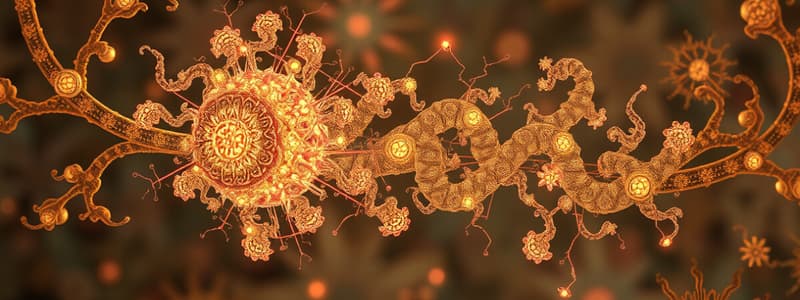Podcast
Questions and Answers
What physiological effect does glucagon have on glucose production in the liver?
What physiological effect does glucagon have on glucose production in the liver?
- It depletes glucose reserves in the liver.
- It inhibits glucose production.
- It stimulates glucose production. (correct)
- It has no impact on glucose production.
What is a characteristic of Type I diabetes mellitus?
What is a characteristic of Type I diabetes mellitus?
- Glucose uptake by cells is enhanced.
- Insulin resistance develops over time.
- Severe pancreatic dysfunction results in insufficient insulin production. (correct)
- It primarily affects older adults.
How does diabetes mellitus contribute to atherosclerosis?
How does diabetes mellitus contribute to atherosclerosis?
- By enhancing inflammation in the blood vessels.
- By promoting excessive LDL cholesterol production.
- By causing endothelial damage due to high glucose levels. (correct)
- By increasing fat absorption in the intestines.
What distinguishes HbA1c testing from fasting blood glucose testing?
What distinguishes HbA1c testing from fasting blood glucose testing?
What are the symptoms associated with excess glucose in urine due to diabetes mellitus?
What are the symptoms associated with excess glucose in urine due to diabetes mellitus?
What issue primarily affects Type II diabetes mellitus patients regarding insulin?
What issue primarily affects Type II diabetes mellitus patients regarding insulin?
What condition is identified as pre-diabetes based on fasting blood glucose levels?
What condition is identified as pre-diabetes based on fasting blood glucose levels?
What does polydipsia refer to in the context of diabetes mellitus?
What does polydipsia refer to in the context of diabetes mellitus?
What is one of the fates of the energy released from breaking phosphate bonds in ATP?
What is one of the fates of the energy released from breaking phosphate bonds in ATP?
Which of the following pathways is NOT involved in the production of ATP from carbohydrates?
Which of the following pathways is NOT involved in the production of ATP from carbohydrates?
What role does phosphocreatine play in energy transfer?
What role does phosphocreatine play in energy transfer?
What is the primary end product of glycolysis when glucose is used as a substrate?
What is the primary end product of glycolysis when glucose is used as a substrate?
During which time frame can glycolysis sustain ATP production independently of oxidative metabolism?
During which time frame can glycolysis sustain ATP production independently of oxidative metabolism?
Which energy source is ranked as the most abundant in the body?
Which energy source is ranked as the most abundant in the body?
Which hormone is primarily responsible for the uptake of glucose into cells, lowering blood glucose levels?
Which hormone is primarily responsible for the uptake of glucose into cells, lowering blood glucose levels?
What is the process called that involves the formation of new glucose from amino acids?
What is the process called that involves the formation of new glucose from amino acids?
What is the primary function of leukocytes during inflammation?
What is the primary function of leukocytes during inflammation?
What process allows leukocytes to migrate out of blood vessels during inflammation?
What process allows leukocytes to migrate out of blood vessels during inflammation?
Which inflammatory mediator is primarily responsible for increasing vascular permeability?
Which inflammatory mediator is primarily responsible for increasing vascular permeability?
What effect does stasis have during the inflammatory response?
What effect does stasis have during the inflammatory response?
What is the role of lymphatic vessels during inflammation?
What is the role of lymphatic vessels during inflammation?
What is the main characteristic of lymphangitis?
What is the main characteristic of lymphangitis?
During margination, what allows leukocytes to adhere to endothelial cells?
During margination, what allows leukocytes to adhere to endothelial cells?
What is the purpose of chemotaxis in inflammation?
What is the purpose of chemotaxis in inflammation?
Which of the following events is primarily associated with the sign of edema in inflammation?
Which of the following events is primarily associated with the sign of edema in inflammation?
Which of the following best describes chronic inflammation?
Which of the following best describes chronic inflammation?
Which condition is an example of chronic inflammation due to the inability to regenerate tissue?
Which condition is an example of chronic inflammation due to the inability to regenerate tissue?
What best characterizes exudate compared to transudate?
What best characterizes exudate compared to transudate?
In the context of inflammation, what triggers the formation of granulation tissue?
In the context of inflammation, what triggers the formation of granulation tissue?
Which statement accurately differentiates exudate from effusion?
Which statement accurately differentiates exudate from effusion?
What is a common cause of pain in inflammation?
What is a common cause of pain in inflammation?
Which factor primarily drives the movement of plasma proteins and cells to the injury site during inflammation?
Which factor primarily drives the movement of plasma proteins and cells to the injury site during inflammation?
Flashcards are hidden until you start studying
Study Notes
Energy from ATP
- Energy released from breaking phosphate bonds in ATP drives chemical reactions and generates heat.
ATP Production Pathways
- Combustion of Carbohydrates
- Involves glycolysis and the citric acid cycle.
- Combustion of Fatty Acids
- beta-oxidation process.
- Combustion of Proteins
- Occurs after proteins are broken down into amino acids.
Role of Phosphocreatine
- Functions in a reversible reaction to generate ATP.
- Reaction: Phosphocreatine + ADP ↔ ATP + Creatine
- Moves right to maintain ATP levels when they are slightly depleted, acting as an ATP “buffer.”
- Moves left when ATP demand is low, resynthesizing phosphocreatine.
- Serves as an “immediate” source of chemical energy, also known as “creatine phosphate.”
End Products of Glycolysis
- Produces 2 molecules of pyruvate.
- Generates ATP:
- 2 ATP if glucose is used.
- 3 ATP if glycogen is used, indicating glycogen is a better energy source than glucose.
Sources of Anaerobic ATP Production
- Existing ATP in cells lasts approximately 1 second.
- Phosphocreatine can sustain energy for 5-10 seconds.
- Glycolysis provides ATP for around 30-60 seconds.
Energy Sources Ranking
- Highest energy source: fat mass.
- Glycogen acts as the storage form of glucose, found in liver, skeletal muscle, and kidney.
- Glucose is present in the bloodstream.
- Protein is abundant but not typically used for ATP production.
Blood Glucose Regulation
- Glycogen Production: Glucose converted into glycogen, activated by insulin.
- Glycogenolysis: Breakdown of glycogen into glucose.
- Gluconeogenesis: Formation of glucose from amino acids.
- Regulated by hormones:
- Insulin: Lowers blood glucose by promoting cellular uptake and inhibiting gluconeogenesis.
- Glucagon and Epinephrine: Stimulate glucose production in the liver.
Diabetes Mellitus Overview
- Characterized by excess blood glucose, leading to sweet-tasting urine due to unabsorbed glucose.
- Type I Diabetes:
- Previously known as “juvenile diabetes.”
- Results from primary pancreatic dysfunction; insufficient insulin production, often immune-mediated.
- Type II Diabetes:
- Sufficient insulin is produced, but receptors are less responsive.
- Unable to facilitate glucose uptake in skeletal muscle and adipose tissue, resulting in elevated blood glucose levels.
Diabetes and Atherosclerosis
- Excess glucose damages endothelial cells.
- Results in the formation of atherosclerotic plaques affecting blood vessel function.
- Reduces blood flow to organs, leading to conditions like heart disease, retinopathy, and kidney failure, increasing heart attack and stroke risk.
HbA1c Test
- Definition: Hemoglobin A1C is glycosylated hemoglobin that reflects glucose exposure.
- Provides average blood glucose levels over several weeks, offering more useful information than a singular fasting blood glucose reading.
- May indicate impaired glucose tolerance even if fasting blood glucose appears normal.
Pre-diabetes Description
- Defined by fasting blood glucose levels above normal (>100mg/dL) but below the diabetes threshold.
Signs of Inflammation
- Erythema (redness) results from vasodilation and enhanced blood flow.
- Heat in the affected area also arises from vasodilation and increased blood flow.
- Edema occurs due to increased vascular permeability and hydrostatic pressure, causing fluid filtration into interstitial spaces.
- Pain has multiple causes including direct trauma, pressure from edema, swelling of nerve endings, and chemical mediators.
Acute vs. Chronic Inflammation
- Acute Inflammation: Characterized by edema (fluid and plasma proteins) and infiltration of neutrophils.
- Chronic Inflammation: Involves lymphocytes, plasma cells, macrophages, angiogenesis, fibrosis, granulation tissue, and ongoing tissue destruction.
Conditions Causing Inflammation
- Acute: Common triggers include infections, tissue necrosis, foreign bodies, and immune reactions.
- Chronic: Results from extensive necrosis, inability to regenerate tissue (especially in the heart, CNS, and PNS), persistent injurious agents, and repeated acute inflammation episodes.
Granulomatous Inflammation
- Defined by aggregates of macrophages and lymphocytes that may form granulomas, showing a chronic inflammatory response.
Exudate, Transudate, and Effusion
- Exudate: High protein fluid with significant cellular content due to increased vascular permeability.
- Transudate: Low protein fluid with minimal cellular content, emerges under normal vascular conditions without increased permeability.
- Effusion: The accumulation of exudate or transudate into anatomical or potential spaces.
Role of Vascular Alterations in Inflammation
- Aims to facilitate plasma proteins and white blood cell movement to the injury site, termed "exudation".
- Increased capillary permeability leads to leakage of fluid and proteins.
- Initial vasodilation causes increased blood flow; later, blood viscosity rises, reducing flow.
- Increased fibrinogen leads to clotting, aiding in the localized inflammatory response.
Role of Leukocytes in Inflammation
- Function to eliminate harmful stimuli, release toxic substances, engage in phagocytosis, and release growth factors for healing.
- Stasis occurs from blood vessel engorgement and slowed blood flow.
- Margination involves leukocyte accumulation on endothelial surfaces facilitated by adhesion molecules.
- Diapedesis allows leukocytes to migrate from blood vessels into interstitial spaces.
- Chemotaxis guides the directed movement of leukocytes to the site of inflammation using chemokines.
Lymphatic System in Inflammatory Response
- Lymphatic vessels drain exudate, which helps reduce edema and remove inflammatory stimuli and leukocytes.
- Phagocytes present antigens to B and T cells in lymph nodes, promoting lymphocyte proliferation and leading to lymphadenopathy if necessary.
Lymphangitis
- Characterized by inflammation of lymphatic vessels, noted by red streaks under the skin and tenderness upon palpation.
Key Inflammatory Mediators
- Histamine: Synthesized in mast cells, basophils, and platelets; promotes endothelial contraction, increases vascular permeability, induces exudation, causes vasodilation, and can lead to bronchoconstriction.
Studying That Suits You
Use AI to generate personalized quizzes and flashcards to suit your learning preferences.




